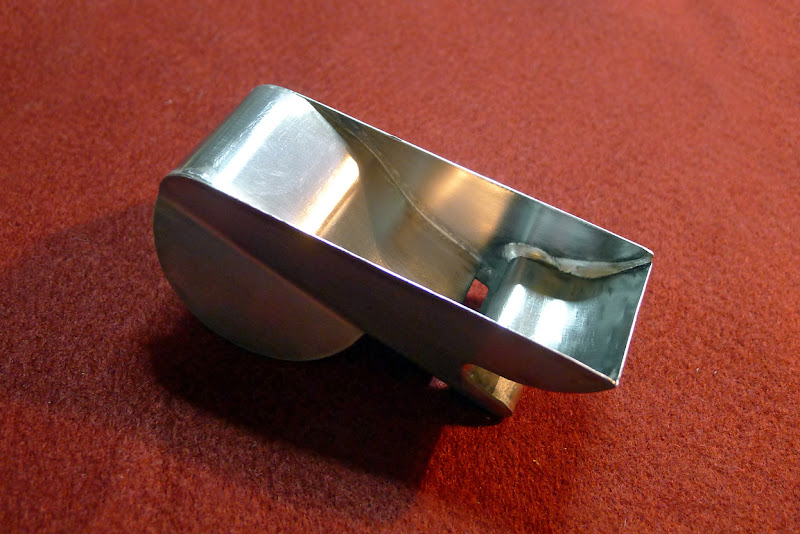[Sequel of the post Grierson's Whistle: drawing a template]
In his patent, Alexander Roxburgh Grierson specified his whistle was made of metal sheet. So I used (again) a 0.5mm thick tin plate, and glued my template.

I roughly cut the piece with a pair of shears, and began by the easiest: rounding the upper lip rest around a pencil :) Whether it had been manufactured, the Grierson's whistle would have been stamped, and this lip rest would have been the the "positive" of the mouth hole. I'm not able to stamp tin sheets, so I cut a separate part that I will solder at the right position.

Then I shaped the parts more precisely with a file. I also used a metal punch to cut the narrow curve of the wings, and also to remove metal from the mouth and nose holes, before finishing them with the file.

 |  |

Bending the longest part was a very difficult task. I used pencils and rods of different diameters.

 |  |



Then I began the soldering, and noticed 1mm was lacking at the very end of the curves. I had suspected that those curves would have "eaten" some length, but my cardboard model was made of a thinner material than the tin sheet, and I made this little mistake...



Finally, I soldered the upper lip rest.

Then I filed and sanded the instrument. It is far from being perfect... But it's been the most difficult replica I made so far. And I'm not proud of the quality of my solderings...


To be continued!
---
On the same topic :
- Historic Nose Flutes - The Nasalette: Template
- Historic Nose Flutes - The Nasalette: Building
- Historic Nose Flutes - The Nasalette: Review
- Historic Nose Flutes - Couchois' Whistle: Template
- Historic Nose Flutes - Couchois' Whistle: Building
- Historic Nose Flutes - Couchois' Whistle: Review
- Historic Nose Flutes - Grierson's Whistle: Template
- Historic Nose Flutes - Grierson's Whistle: Building
- Historic Nose Flutes - Grierson's Whistle: Review
---

I can tell this must have been the most difficult nose flute by far... It looks great!
ReplyDeleteIt is amazing to see it replicated and possibly built for the very first time! I really look forward to hear how it sounds. The only way to know what it can do is by having it replicated as you did. There could be an element in the design that proves to be highly efficient.
I wonder if you eventually consider applying improvements to any of the replicas you have built. Moreover, I wonder if you possibly even consider combining extraordinary elements from various designs and incorporate them in a new design of your own.
What a beautiful and accurate work! I wish I had half of your patience! Yet I cannot help but think what great cookie cutters, surely in the shape of a noseflute, one could build out of that nice material. In this case I would prefer the unchromed version. Imagine, christmas cookies in the shape of noseflutes (sure, bit difficult for the three dimensions...).
ReplyDeleteNose flute cookies for feed the diva!!
yours sincerely, the Nosy Diva
@ Maikel: well, i do not intend to apply improvements to the replicas. My goal is to study an historic object. Parallely, I sometimes build a totally new nose flute (my own design), and this is to improve my technical knowledge.
ReplyDeleteAnyway, besides changing the fipple dimensions, the only way to improve a nose flute is... to redesign it totally!
@ Nosy (greedy) Diva: hahaha! Cookies cutters! For a flat cookie, it should be possible. For a 3D cookie, ask Mr. Schuermans and his injections machines!:)